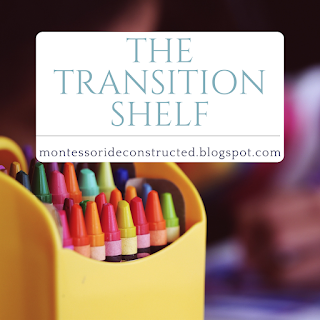The Transition Shelf
Are you familiar with the "transition shelf" in a Montessori classroom? There are many Montessori trainings that don't talk much about it. This would be a shelf set up with temporary activities for new children. Temporary meaning they are only offered for a few weeks and then they are removed until you may have the opportunity to welcome in another group.
New children, especially the youngest in our groups, can arrive at school eager to get those little hands on the exercises, but are sad to find that they can't just take what they want, they have to wait for a lesson. As the teacher with only two hands and a room full of children, there are only so many new lessons that you can give a new child in the first couple of days while you are still meeting the needs of the rest of the group. The last thing we want to do is smother the excitement of a new student!
Enter the transition shelf! The exercises that we would put together on this shelf are specifically for the new children. They should be activities that are familiar to the child, fun, and ones that do not require a lesson or much of one. This shelf allows the children to join in the rhythm of the classroom by being able to work with something enjoyable...just like their more experienced peers! Like the other areas of the room, the child enjoys free choice of what they would like to take, they experience a full three-step cycle of work, chances are they will begin to feel a lot more comfortable having something to do, and you get a little time to support other children in the class.
This shelf does not replace the job that adult has in relationship building though! Our top priority is connecting with the children. Singing songs, going for short walks, kicking the ball on the playground, reading a book, doing finger plays, and having good old conversations are the way to build a trusting relationship.
Let's get back to that transition shelf-what are some activities we could offer?
- Wood puzzles
- Knobbed puzzles
- Pasta necklaces stringing (I loved using food coloring to dye ditalini pasta for this)
- Cut colorful straws to make beads for bracelets or necklaces
- Play dough with cutters
- Lock and latch boards
- Lacing boards (you can cut shapes out of the paperboard cracker boxes and punch holes along the edges)
- Crayons and paper for coloring
- Visual sorting like large colorful buttons or shells
- Unpacking and packing a lunchbox (add plastic containers for the child to practice opening)
- Nesting dolls


Comments
Post a Comment